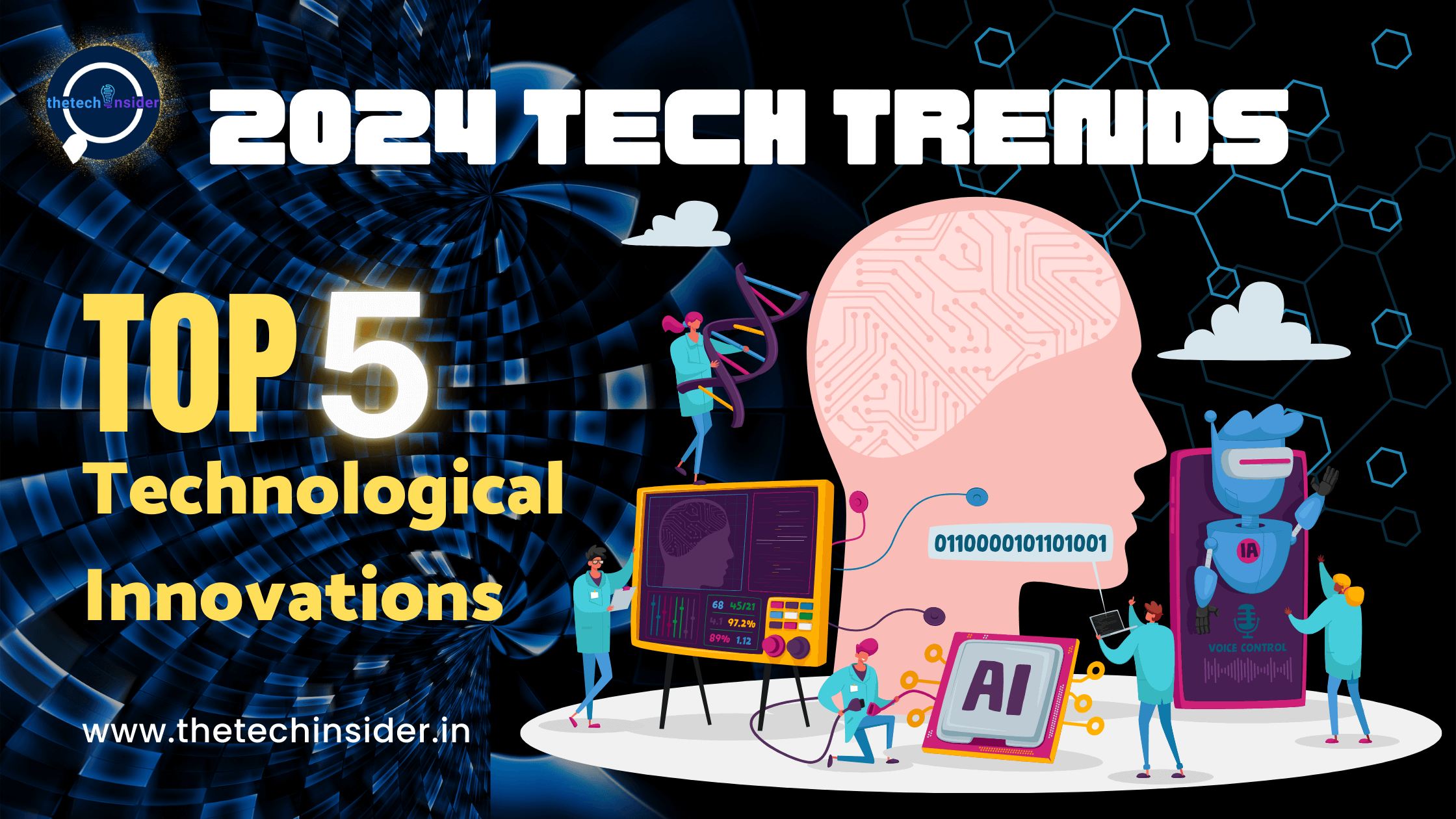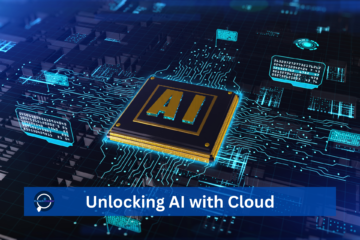With technology being a great leveler, the world has become flat and offers equal opportunities to all. The person who uses these opportunities at the right time and in the right way shall reach the top of his game and may even have a chance of reaching the top 1%.
Since this is the era of technology, obviously the path to reach the top is through technology, and more precisely by simply following the technology trends and technological innovations.
In this blog we shall go through the top 5 technology trends which you should follow if you want to gain success in 2024. Uncover 2024’s top Technological Innovations and trends! Explore new technology in India, upcoming advancements, and the latest in 2024’s tech landscape.

Artificial Intelligence and Machine Learning
What is Artificial Intelligence?
Artificial intelligence is a broad field, which refers to the use of technologies to build machines and computers that have the ability to mimic cognitive functions associated with human intelligence, such as being able to see, understand, and respond to spoken or written language, analyze data, make recommendations, and more.
Although artificial intelligence is often thought of as a system in itself, it is a set of technologies implemented in a system to enable it to reason, learn, and act to solve a complex problem.
What is Machine Learning?
Machine learning is a subset of artificial intelligence that automatically enables a machine or system to learn and improve from experience. Instead of explicit programming, machine learning uses algorithms to analyze large amounts of data, learn from the insights, and then make informed decisions.
Machine learning algorithms improve performance over time as they are trained—exposed to more data. Machine learning models are the output, or what the program learns from running an algorithm on training data. The more data used, the better the model will get.
Why are they the new technological Innovations in 2024?
In the vast landscape of technological evolution, Artificial Intelligence (AI) and Machine Learning (ML) lead the parade. Even in today’s time the most studied course in science is AI and ML. These technologies have not only come to redefine the way we interact with our devices but are becoming an integral part of our day today life.
For example: AI is being used in your smartphone to suggest your words on the basis of what you are typing, promote webpages on the basis of what the customer searches mostly on the web.
It has been integrated in your life from automatically dimming, or brightening the light of our phones to being used in the armed forces and healthcare. From voice assistants to predictive text, AI is already an intrinsic part of our digital experiences.
Machine Learning, a subset of AI that enables systems to learn and improve from experience, is on the brink of remarkable advancements. Predictive analytics, personalized recommendations, and enhanced natural language processing are just a glimpse of what the future holds.
The adoption of AI today is 2.5x higher than it was in 2017 — about 50% of organizations have adopted AI for at least one business function. With open-source AI solutions and lower cost and complexity of systems, the democratization of AI is in full swing.
The proof that the companies that opted for AI as their major product have flourished exponentially is given by Open AI.
It’s currently worth 29 Billion Dollars. And, the company expects to hit $1 billion in revenue in 2024. OpenAI’s ChatGPT surprised the world when it was released in November 2022, and within such a short period of time it has taken over the world.
More than 100 million people used ChatGPT within the first two months of its release.
Seeing the success of Chat GPT, Google launched Bard and Microsoft launched Bing Chatbot.
According to a PwC survey, the top goals of business leaders who are adopting AI are increasing productivity through automation, improving decision-making, and boosting the customer experience.
AI is helping to make people’s lives easier, making more satirical based decisions in business. It is one of the fastest growing technologies in India.

Cybersecurity Innovations
Cyber security is the practice of defending computers, servers, mobile devices, electronic systems, networks, and data from malicious attacks. It’s also known as information technology security or electronic information security. The term applies in a variety of contexts, from business to mobile computing.
Why is this technological innovation an opportunity for the near future?
In an era dominated by interconnected systems, the importance of robust cybersecurity measures cannot be overstated. As technology advances, so do the threats, making cybersecurity innovations a critical component of our digital future.
One of the biggest trends in the future of cybersecurity is the use of artificial intelligence (AI) and machine learning (ML) technologies.
AI and ML algorithms are able to analyze large amounts of data and detect patterns and anomalies that may indicate a potential threat. This allows organizations to quickly identify and respond to cyber-attacks, reducing the risk of damage and minimizing the impact of a breach.
Another upcoming technology in cyber security is Blockchain technology. Blockchain is a decentralized ledger that can be used to securely store and transfer information. Because of its decentralized nature, it is much harder for cybercriminals to compromise a blockchain network, and so it is becoming increasingly popular for applications that require high levels of security.
Cyber security is one of the very rare technologies whose use is required in almost every field. Whether it be a bank, that needs to protect itself from cyber security so that the money in the form of digital entries doesn’t just get hacked or something of national importance, for example, the military organizations like RAW, ISI, FBI and many more who need to protect the sensitive and classified information from hackers.
Cybersecurity and cloud computing are closely related, as the increased use of cloud computing has led to new security challenges and concerns.
One of the biggest security concerns with cloud computing is the risk of unauthorized access to sensitive information. This can occur if cybercriminals are able to compromise the security of the cloud provider’s servers, or if they are able to steal login credentials or other information that allows them to access the cloud-stored data.
A 2022 global survey from Hiscox showed 43% of companies reported a cyber-attack in 2021 and 48% reported at least one in 2022.
The most frightening statistic from that report was the fact that 20% of attacked organizations said the cost of the damage threatened their solvency.
In a 2022 survey from VMware, 66% of participating IT leaders said they’d experienced a deepfake-related attack within the past 12 months. That’s an increase of 13% since 2021.
All of this just proves that there is one of the technologies that’s going to boom in the year 2024
Companies are willing to pay a heavy amount of money to the person who has the appropriate knowledge of these areas of study.
Quantum Computing
What is Quantum Computing?
Quantum computing is a multidisciplinary field comprising aspects of computer science, physics, and mathematics that utilizes quantum mechanics to solve complex problems faster than classical computers. The field of quantum computing includes hardware research and application development.
What is a qubit?
Quantum bits, or qubits, are represented by quantum particles. The manipulation of qubits by control devices is at the core of a quantum computer’s processing power. Qubits in quantum computers are analogous to bits in classical computers. At its core, a classical machine’s processor does all its work by manipulating bits. Similarly, the quantum processor does all its work by processing qubits.
Why is Quantum Computing a revolutionizing innovation?
As we push the boundaries of classical computing, Quantum Computing emerges as a frontier that promises unparalleled computational power. Quantum computing leverages the principles of quantum mechanics to perform calculations that were previously thought to be impossible for classical computers.
Unlike classical bits, which can only exist in a state of 0 or 1, quantum bits or qubits can exist in multiple states simultaneously, opening the door to exponential computational possibilities.
Quantum computing has been a topic of discussion since the 1980s. Fast forward to 2024 and the world is finally close to achieving real-world applications for this type of computing.
$35.5 billion was invested in the technology across public and private sectors in 2022.
So far, the leader in the race to quantum computing is IBM. Osprey, IBM’s quantum computer, was unveiled in November 2022 and boasts 433 qubits. This is a huge milestone considering that the classical computers only had 2 bits (1 and 0). The company says they’ll have a computer with 4,000 qubits by 2025.
A report from McKinsey says quantum computing will provide the highest value in the life sciences and financial sectors. Up to $700 billion in value may be realized by 2035, according to McKinsey.
Quantum computing could have various consumer-facing impacts, as well. Take electric vehicle charging, for instance.
It takes an average of 10 hours to fully recharge an electric car at home. Even the fastest charging speeds which are available at speed charging stations still take 20 minutes.
With quantum technology, charging time could potentially be cut down to just three minutes at home and a few seconds at high-speed charging stations.
All of this technology boils down to an increased speed of computation. Complex calculations done by today’s computers might take millions of years, but they can be solved in minutes with quantum computing.
So, if you have the knowledge of how to control and make a quantum computer work for you, well you are on the right path.
Internet of Things (IoT)
What is an Internet of Things(IoT)?
The Internet of Things (IoT) describes the network of physical objects—“things”—that are embedded with sensors, software, and other technologies for the purpose of connecting and exchanging data with other devices and systems over the Internet. These devices range from ordinary household objects to sophisticated industrial tools.
Why is the Internet of Things (IoT) an opportunity for the future?
The proliferation of connected devices marks the era of the Internet of Things (IoT), where everyday objects are equipped with sensors and connectivity, creating an intricate web of data that has the potential to reshape industries and enhance our daily lives.
In the most basic words IOT refers to the connectivity of the the hardware to the software signals via the usage of a software.
Despite ongoing chip shortages, the number of global IoT connections is expected to grow to 27 billion by 2025.
The IoT ecosystem is experiencing exponential growth, with devices ranging from smart home appliances and wearables to industrial sensors and autonomous vehicles. The true power of IoT lies in the interconnection of devices and letting them communicate seamlessly.
Computer Science Engineering with specialization in IoT or Computer and Communication Engineering are the new popular courses of study in India.
In smart cities, IoT facilitates real-time data collection for traffic management and energy optimization. In agriculture, IoT sensors monitor soil conditions and crop health, optimizing yield and resource usage.
For an agriculture-based country like India, IoT is going to be the next technological trend in India.
In a 2022 survey from IEEE, IoT was ranked as one of the top five most impactful technologies of 2023. Businesses are seeing relatively quick ROI on their IoT projects. More than 60% say they’re reaching financial payback in just three years.
Robotics and Automation
What is Robotics and Automation?
Automation and robots are two distinct technologies, but the terms are often used interchangeably. Together, they have transformed the manufacturing space.
Formerly time-consuming duties are now fully automated with minimal operator input, and robots are taking over more labor-intensive and hazardous tasks from humans.
How can these two technologies together shape the future?
As we enter the age of Industry 4.0, Robotics and Automation emerge as transformative forces, reshaping industries and revolutionizing the way we work.
As the lines between artificial intelligence and machine learning continue to blur, businesses are finding an increasing number of ways to integrate automation into their processes.
A restaurant in Jaipur, Rajasthan, India has replaced waiters and has kept robots to make sure that the meals of the customers reach the customer’s table.
Believe it or not it is the next technology trend which you should focus on.
We can easily prove that with some statistics.
And one of the emerging technologies executives are most excited about is robotic process automation (RPA). RPA involves training software programs to perform or execute mundane, repetitive tasks. Forecasts predict the RPA market to grow to 25 billion dollars by 2030 with a CAGR of nearly 36%. In 2022, RPA software spending reached nearly $3 billion — a 21% increase from 2021.
Surveys report that one-fifth of businesses are currently employing RPA. RPA solutions can also save time and money when it comes to low-value, mundane tasks done within a business.

As we navigate the technological landscape of 2024 and beyond, these trends collectively paint a picture of a world. It is the right time to invest your time to learn these skills and educate yourself so that in the near future you can take total advantage of these technological trends and become the top 1%.
Also keep following The Techinsider for such regular technological updates.
We are always updating our website to give you the newest, the most fresh, most updated and most authentic information.
The Techinsider – Decoding tomorrow’s technology today.




